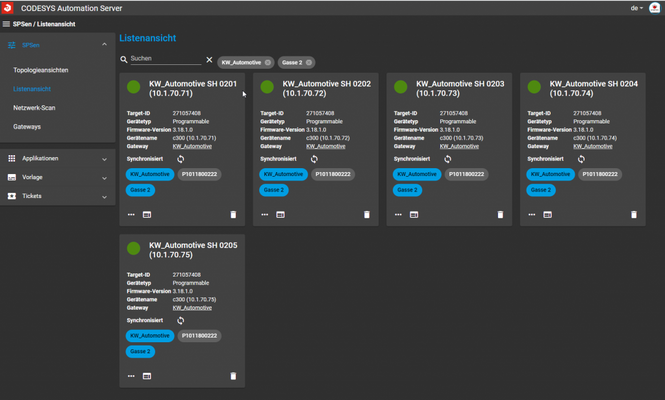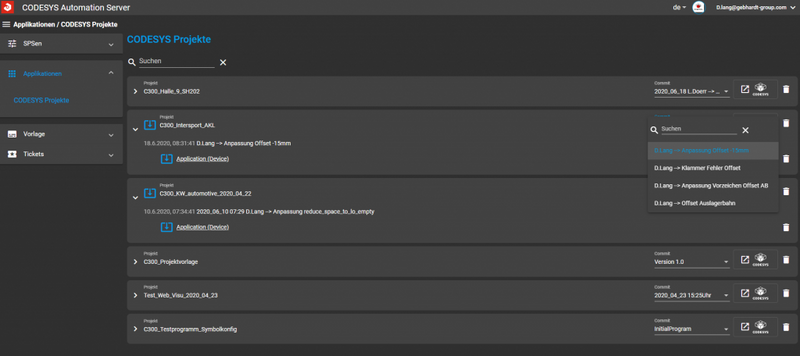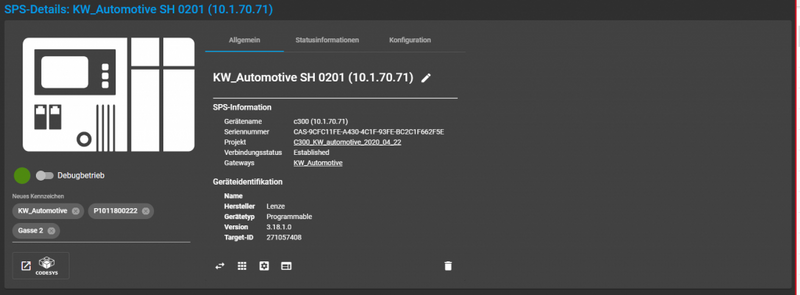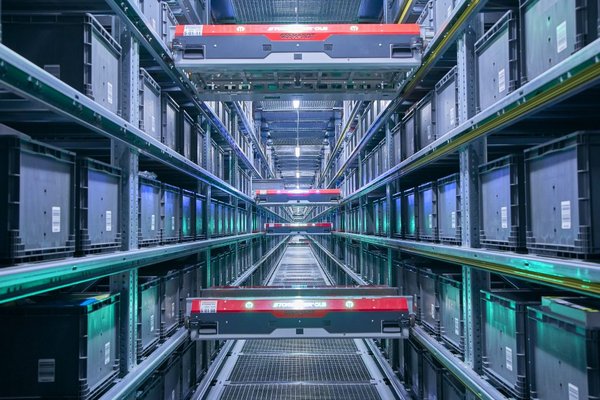Gebhardt develops and produces complete intralogistics solutions with around 650 employees: from the conveyor roller to the complete storage and retrieval machine. One of the products, the StoreBiter 300 OLS, is a storage system for high-performance requirements and is controlled by a CODESYS-based Lenze PLC of type C300. Different load-handling attachments make this a very flexible system for the single or multiple-depth storage of containers, trays, and cartons of various sizes. It is suitable, for example, for the implementation of the goods-to-man principle, especially in connection with Gebhardt's SimplePick picking stations. The storage system can consist of one or more aisles in which several shuttles can be used. Each aisle is divided into several levels, depending on the warehouse height. Depending on performance requirements, each level is equipped with a shuttle or the number of shuttles is reduced accordingly. At the end of each aisle there are lifting devices that allow the containers to be delivered or the shuttles to change levels. Through a modular design of the individual system components, individual solutions can be developed that are tailored to the respective customer requirements.
Complex controller updates
How can the networked controllers of such a shuttle system be updated? The long-established procedure enabled the management of the installed base of storage systems. For example, Dominik Lang, responsible for the PLC Development & Standardization OLS 2D & X department at Gebhardt, reports that until now a virtual maintenance machine has been set up for each customer on the in-house server, which is connected to the customer network via VPN. Although there was no overview of the operating status of the customer's shuttles, it was still possible to connect to individual shuttles in order, for example, to update them. A small tool was specially developed for the commissioning of the controllers in order to install an update of the shuttle application on site via an FTP server. However, this procedure only worked locally, i.e. only if the commissioning was carried out at the plant location. The source code was versioned in Windows folders on the server. Gebhardt's application developers exchanged the CODESYS projects via this directory structure. With the success of the storage system and the 900 installed shuttles, it became clear over time that support and updates are time-consuming and organizationally complicated. For a single customer, such an update could drag on for several hours. During this time, the entire aisle had to be shut down, and no orders were allowed to be processed. Thus, the required time window had to be precisely coordinated with the customer in advance and met with very little acceptance. At the same time, there is a high level of update pressure on the customer side. This results in a very critical situation, especially during the commissioning that lasts about a week, when the system is adapted to the customer's wishes. For Lang and his colleagues it is always a particularly stressful time, although they always try to arrange downtimes outside of the customer's working hours.
Cloud-based controller administration
How can the three-man development team speed up the update process? In search of a solution, nothing was found on the market that met the requirements. An essential criterion was that the effort required to maintain a suitable infrastructure should be as low as possible. In 2019, a technical article drew the developers’ attention to the CODESYS Automation Server, which was still in the beta phase then. Lang started initial attempts at his desk to integrate controllers into the server, to load source code and the binary applications for the controllers into his tenant, i.e. his protected server account, and to transfer these applications to the connected controllers. Extensive help documentation and some short YouTube videos were enough to allow him to quickly find his way around the intuitively operated system. After about half a day, the first controllers were connected to the CODESYS Automation Server. Gebhardt was thus convinced that this solution is suitable for significantly accelerating the update procedure described. Following the desk experiment and minor adjustments to the CODESYS Automation Server to provide the best possible support for the C300 controllers, the next step was taken: the connection of the CODESYS Automation Server to the company's own real warehouse in Sinsheim. After the required applications had been loaded to the server and the controllers were integrated, the application software was rolled out to the controllers via the server. For a direct comparison, the application software was put into operation in another warehouse using the previous procedure. The difference was clear: While it took Dominik Lang and his colleagues about two hours to set up the warehouse with their existing process, the warehouse was in operation with the Automation Server after 20 minutes – six times faster.
Versioning in focus
The application Software was not only automatically rolled out to all controllers via the CODESYS Automation Server, but was also clearly versioned at the same time. From this point on, the developers always had an overview of which application version is running on which controller. It was possible to retrieve the source code directly from the server for further editing. In order to keep their project statuses in sync, the software developers no longer use a Windows folder; instead, they use the mechanisms of the CODESYS Automation Server. They observed the interaction between the server and the control world in the warehouse over a lengthy period of time. Stability, high uptime and data security were analyzed in detail. In February 2020, the decision was taken to realize the first customer project with the CODESYS Automation Server. A total of 15 controllers were connected and put into operation in a new system within half a day. Tags are used on the controllers for structuring within the server. They allow filtering according to the project and within the project according to the aisles in which they are used. The benefits of the CODESYS Automation Server are so high for Gebhardt that its use is planned for all new projects. Recently, the cloud-based platform has even been gradually adopted into Brownfield projects. For example, Lang and his colleagues now conveniently manage the 70 controllers and their PLC applications in the Intersport Deutschland warehouse via the cloud-based platform. "The Automation Server saves us a considerable amount of time and is also a suitable platform for connecting with one another," Lang concludes.
The article by Samuel Greising, Product Manager at CODESYS GmbH, was published in German language in SPS Magazin and in "Der Maschinenbau", issue 09/2020.












